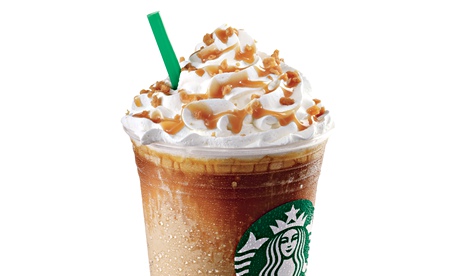
One Starbucks caramel frappuccino with skimmed milk and whipped cream contains nearly twice as much sugar as the World Health Organisation says is the advisable daily intake, and a can of Coca-Cola or Pepsi has one and a half times the amount, but campaigners worry that the message about cutting down on sugar is insufficiently clear.
In a draft updated guideline on sugar consumption, WHO recommended on Wednesday that no more than 10% of our calories should come from sugar, but suggested less than 5% would be preferable.
For an average adult consuming 2,000 calories a day, that equates to 50g of sugar – or 12 teaspoons – at the higher limit and 25g – six teaspoons – at the lower limit.
A child, whose calorie intake is much lower, would reach the limit even faster.
The Starbucks caramel frappuccino contains more than 44g of sugar – 11 teaspoons – which is considerably above the lower limit and almost at the upper limit, suggesting that it could be unwise to drink one at all.
Coca-Cola and Pepsi in 330ml cans have nine teaspoons of sugar, a 51g Mars bar has eight teaspoons and a Muller Crunch Corner strawberry shortcake yoghurt six teaspoons. There is added sugar in many savoury dishes, including pasta sauce and soup, to improve taste and texture.
Aseem Malhotra, cardiologist and science director of the pressure group Action on Sugar, which produced the table of foods with added sugars at its launch in January, said most people would find it hard to calculate how much sugar they are consuming, and are not helped by labels.
Malhotra points out that many manufacturers add together the WHO recommendation of 10% of added sugars and a further 10% of intrinsic sugars – those from fruit and vegetables, which were the subject of a separate nutritional recommendation by the WHO in 2003 to try to persuade people to eat more of them. As a result, Coca-Cola can say that the 35g of sugar in a 330ml can is 39% of an adult's guideline daily recommended amount of total sugars, even though it contains only added sugar.
"This is extremely misleading," said Malhotra. "I agree with the WHO recommendation, but it has to be translated into something meaningful for the consumer."
Public Health England responded to the WHO announcement by accepting the 10% limit recommendation. It went further, adding that it "will carefully consider the suggestion that a further reduction of sugar to below 5% of total energy intake per day would have additional benefits." The UK already has a 10% limit guideline. Surveys suggest that adults in England consume 11.6% of their calories as sugar and children 15.2%.
The WHO recommendation is a response to the growing obesity epidemic, which is a cause of increased heart disease, strokes, type 2 diabetes and some cancers, and also tooth decay.
But the food and drink industry appeared to be relaxed over the guidelines. Barbara Gallani, director of regulation, science and health at the Food and Drink Federation, said: "The main recommendation in the draft guidance … supports the existing UK policy on sugars, that intake of free sugars should not exceed 10% of total energy. Where weight gain is referenced in the draft guidance, this too supports current UK government policy and industry action to reduce calories in the diet.
"Excess calories, whether from fat, sugars or other nutrients, can result in weight gain, which is why UK food and drink producers are working to reduce calories in their products, many doing so under the UK government's Responsibility Deal calorie reduction pledge." The federation pointed out that the WHO said there was greater uncertainty about the science underpinning a 5% limit.

